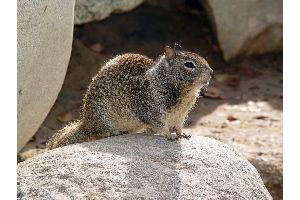California ground squirrels use several behaviors to avoid predation by rattlesnakes. Females chew shed rattlesnake skin and lick their young to transfer the smell to the young and reduce the chances of rattlesnake predation. Adult ground squirrels have some immunity to rattlesnake venom. When confronted by a rattlesnake, a ground squirrel will heat its tail and shake it, creating the heat image of a larger animal that is too big for the rattlesnake to attack.
Photo Credit: Howard Cheng
Otospermophilus beecheyi
Common Name: California ground squirrel
Other Common Names: beechy ground squirrel, rock squirrel
Other Scientific Names: Spermophilus beecheyi
Animal Guild: Mammal
Class > Order > Family: Mammalia > Rodentia > Sciuridae
What does the species look like?
Within its range, the California ground squirrel is our largest ground squirrel. Its tail is much longer and bushier than in other ground squirrels. It is most similar in appearance to the gray squirrel, except that its back and sides are lightly spotted. Although it will climb, the California ground squirrel is rarely seen in trees.
Where is the species found?
States & Provinces
CA, NV, OR, WA
Distribution
The range of the California ground squirrel is largely west of the crest of the Cascade and Sierra Nevada, from northern Oregon to northern Baja California, Mexico. There is a small extension of the range into west-central Nevada and east of the crest of the Cascade Mountains in Oregon. California ground squirrels also occur in Washington east of the Cascades, reaching into the southern Columbia Basin, and the range is expanding to the east in this area.
The California ground squirrel is found in old fields, pastures, roadsides, levees, and, occasionally, clearcuts. It will use more open habitat than some ground squirrels, and is also more tolerant of disturbance.
General Phenology and Life History
California ground squirrels generally hibernate from November to February or March. At higher elevations and northern latitudes squirrels emerge later from hibernation than do squirrels at lower elevations and southern latitudes. In fact, pregnant females may be found year round in southern California. Females are more likely to hibernate than males, and adults are more likely to hibernate than young. Breeding takes place shortly after emergence, and young are first seen on the surface nine to ten weeks later.
Which phenophases should I observe?
Do you see/hear...?
Activity
Live individuals More...
For abundance, enter the number of individual animals observed in this phenophase.
Feeding For abundance, enter the number of individual animals observed in this phenophase.
Development
Young individuals For abundance, enter the number of individual animals observed in this phenophase.
Dead individuals For abundance, enter the number of individual animals observed in this phenophase.
What do these phenophases look like?
There is currently no photoguide available for this species. If you'd like help us create one, use the guidance document and species template provided here . Then send it via email to education@usanpn.org when it is complete.
